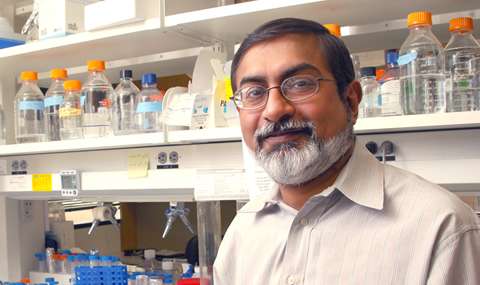Researchers identify a switch that controls growth of most aggressive brain tumor cells

Researchers at UT Southwestern Medical Center have identified a cellular switch that potentially can be turned off and on to slow down, and eventually inhibit the growth of the most commonly diagnosed and aggressive malignant brain tumor.
Findings of their investigation show that the protein RIP1 acts as a mediator of brain tumor cell survival, either protecting or destroying cells. Researchers believe that the protein, found in most glioblastomas, can be targeted to develop a drug treatment for these highly malignant brain tumors. The study was published online Aug. 22 in Cell Reports.
"Our study identifies a new mechanism involving RIP1that regulates cell division and death in glioblastomas," said senior author Dr. Amyn Habib, associate professor of neurology and neurotherapeutics at UT Southwestern, and staff neurologist at VA North Texas Health Care System. "For individuals with glioblastomas, this finding identified a target for the development of a drug treatment option that currently does not exist."
In the study, researchers used animal models to examine the interactions of the cell receptor EGFRvIII and RIP1. Both are used to activate NF?B, a family of proteins that is important to the growth of cancerous tumor cells. When RIP1 is switched off in the experimental model, NF?B and the signaling that promotes tumor growth is also inhibited. Furthermore, the findings show that RIP1 can be activated to divert cancer cells into a death mode so that they self-destruct.
According to the American Cancer Society, about 30 percent of brain tumors are gliomas, a fast-growing, treatment-resistant type of tumor that includes glioblastomas, astrocytomas, oligodendrogliomas, and ependymomas. In many cases, survival is tied to novel clinical trial treatments and research that will lead to drug development.
The Department of Neurology and Neurotherapeutics at UT Southwestern is ranked in the top 20 in the nation, according to U.S. News & World Report. UT Southwestern physicians routinely deal with the most difficult neurology cases referred from around the region, state, and nation.
The research was conducted with support from the National Institutes of Health, NASA, and the Cancer Prevention and Research Institute of Texas.
UT Southwestern investigators who participated in the study include former postdoctoral researcher Dr. Vineshkumar Puliyappadamba, senior research associate Dr. Sharmistha Chakraborty, former research assistant Sandili Chauncey, and senior research scientist Dr. Li Li, all from the Department of Neurology and Neurotherapeutics. Dr. Kimmo Hatanpaa, associate professor of pathology; Dr. Bruce Mickey, director of the Annette G. Strauss Center in Neuro-Oncology; Dr. David Boothman, professor of radiation oncology and pharmacology in the Harold C. Simmons Comprehensive Cancer Center; and Dr. Sandeep Burma, associate professor of radiation oncology, also contributed to the research.
Journal information: Cell Reports
Provided by UT Southwestern Medical Center



















